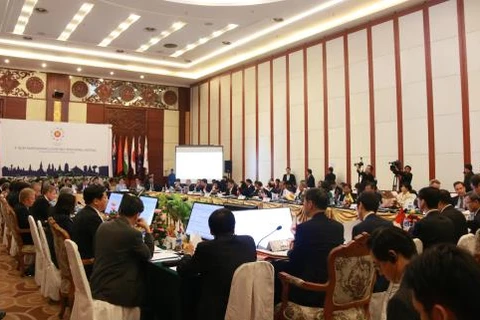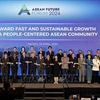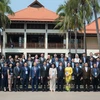 The 8th Mekong - Japan Economic Ministers' Meeting as part of the 48th ASEAN Economic Ministers’ Meeting and related events (Photo: VNA)
The 8th Mekong - Japan Economic Ministers' Meeting as part of the 48th ASEAN Economic Ministers’ Meeting and related events (Photo: VNA) Vientiane (VNA) – ASEAN economic ministers and the Japanese Minister of Economy, Trade and Industry held a consultation in Vientiane, Laos on August 6.
The event took place as part of the 48th ASEAN Economic Ministers’ Meeting and related events, which wrapped up later the day in the Lao capital city. The Vietnamese delegation to the consultation was led by Deputy Minister of Industry and Trade Nguyen Cam Tu.
Hailing the formation of the ASEAN Economic Community in late 2015, Japanese Minister Hiroshige Seko said it will help ASEAN become a more dynamic and competitive region and integrate better into the global economy.
The participating officials expressed their delight that Japan remains the second biggest trade partner and foreign investor in ASEAN.
In 2015, bilateral trade reached 239.4 billion USD, accounting for 10.5 percent of the bloc’s total trade. Meanwhile, Japan invested 17.4 billion USD in FDI in ASEAN, making up 14.5 percent of the total FDI poured into the grouping.
The ministers applauded the finalisation of negotiations on trade in services, including the annexes on finance and telecommunications and the agreement on movement of natural persons, along with the conclusion of talks on investment within the framework of the ASEAN – Japan Comprehensive Economic Partnership (AJCEP).
The two sides recognised continuous efforts to reform the AJCEP implementation while stressing the importance of tax reduction under the AJCEP and the product specific rules in the Harmonised System to facilitate bilateral trade.
They highly valued the progress made in the enforcement of the ASEAN – Japan 10-year Strategic Economic Cooperation Roadmap. They also hailed adaptation of the roadmap to the current situation and agreed to submit the revised roadmap to the upcoming ASEAN – Japan Summit.
The ministers said both sides will together work towards the roadmap’s targets by promoting economic cooperation, ASEAN’s economic integration, and cooperation to integrate the region into the global economy.
They also emphasised the significance of stronger collaboration in other pillars of the roadmap such as infrastructure, human resources and small- and medium-sized enterprise development; technology innovation and transfer; and trade, supply chain and connectivity facilitation.-VNA
























